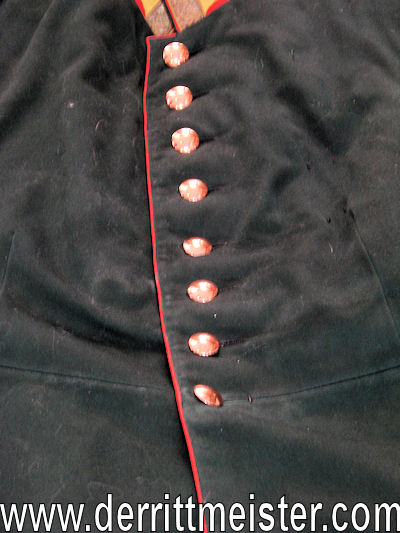Description
This is a first-rate NCO tunic from the Garde-Jäger-Bataillon. The unit was formed in 1744 during the reign of Frederick the Great. This Bataillon along with Jäger-Bataillon Graf Yorck von Wartenburg Nr 1 and Jäger-Bataillon Fürst Bismarck (Pommersches) Nr 2, was one of the oldest Jäger-Bataillons in the German Army, all having been founded in 1744. Each of these Bataillons had a proud history and tradition in first the Prussian and later the German Army. Men assigned to Jäger Bataillons were expected to be crack shots. In the early days during and before the Napoleonic Wars, they were at the head of other German troops, serving as skirmishers. They were to disrupt enemy troops advancing on the German main body.
The tunic is green in color, as is typical of Jäger tunics. It was to offer better camouflage for them when in the field. As with most tunics, this one sports eight gilt buttons down the center. Red piping also runs down the center. The cuffs each sport two more gilt buttons. As the tunic is for an NCO, we see gold bullion braid and two yellow bullion trim pieces where the buttons are attached. Moving to the collar we see the same gold and yellow bullion attached, as well as two Prussian NCO collar buttons in gold. Moving to the shoulder straps, we see plain red examples, which is correct for this Bataillon. Smaller gold buttons displaying the number “2” attach the straps and identify him to Kompagnie Nr 2. On the tunic’s reverse we see red piping in the vent and another six (three on each side) gold buttons.
A tunic for the Garde-Jäger-Bataillon is rare enough, BUT this one is very special in another way. The German Army featured an annual competition to see who had the best marksmanship by regiment type. This was done for the Infanterie, the Artillerie, and etc., as well as for the Jäger Bataillons. So, this competition would have been for “the best of the best,” as Jägers were supposed to excel in marksmanship.
If you examine the tunic’s right sleeve, you will see a special gold device sewn to it. It is the Jäger emblem, a stag’s skull and antlers with a cross attached to the skull between the antlers. Attached to the antlers is a Hohenzollern Crown. The skull’s forehead displays the date “1907.” Our man received the award for 1907. Then, BELOW this are tied oak leaves sporting the date “1908” above them. Our Jäger was a two-time winner of the contest, which is VERY rare. Were the badge available just on its own, it would be worth nearly $1,000. Its attachment to a tunic makes that tunic especially desirable and valuable.
I spoke with a well known German uniform collector and sent him a photo of the badge. He told me the story behind the badge and said in all of his years of collecting, he had seen it only once. He also was fortunate enough to have that one example in HIS extensive collection. The tunic’s interior is in very fine condition with an officer’s quality silk liner. The tunic’s exterior is in near-mint condition. If you were to have only one Jäger tunic in your collection, THIS would be it. If you already have an extensive collection, this example could be its major star.














